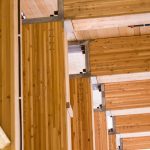 Little plant in dried cracked mud against a background of city skyline.
Little plant in dried cracked mud against a background of city skyline. Modern building techniques utilizing timber are at the forefront of the biggest change in the building industry. Historically reticent to change, the building industry is finally bowing to the needs of sustainability. Although the age of concrete is far from over, there seems to be little doubt that timber is the building material of the future—and that it may help to save the planet.
In North America, the building industry accounts for 37% of CO2 emissions. Concrete has the highest embodied energy at 12.5MJ/kg EE. Steel is a close second with 10.5MJ/kg EE and the lowest is wood with 2.00MJ/kg EE. (Hsu, 2010).
The disturbing IPCC report on global warming has left us only a few years to curb CO2 emissions if we are to stop the march of global warming. This means stemming our CO2 emissions is no longer enough—we have to actually remove the CO2 already in the atmosphere if we are to succeed. From the report:
“The report finds that limiting global warming to 1.5°C would require “rapid and far-reaching” transitions in land, energy, industry, buildings, transport, and cities. Global net human-caused emissions of carbon dioxide (CO2) would need to fall by about 45 percent from 2010 levels by 2030, reaching ‘net zero’ around 2050. This means that any remaining emissions would need to be balanced by removing CO2 from the air.”
The only real way to combat existing CO2 is through forestation. Reforestation on a grand scale needs to be our future and to do so, we must create a demand for more wood. Utilizing timber for building means that the carbon is not only absorbed, it is sequestered in buildings for decades to come.
 One way to create long-term CO2 storage is through cross-laminated timber (CLT) which we can use to build just about anything. This not only sequesters carbon, but also offsets the carbon that would have been created by buildings made of concrete or steel.
One way to create long-term CO2 storage is through cross-laminated timber (CLT) which we can use to build just about anything. This not only sequesters carbon, but also offsets the carbon that would have been created by buildings made of concrete or steel.
CLT isn’t just the latest trend in building materials, it represents a fundamental change in the way we build our cities. Projects that utilize CLT can be carbon positive. That means they don’t just stop any new carbon from entering the atmosphere, but they actually sequester more than their construction creates. Another bonus is that CLT is sourced from sustainable forests, so the process is a real step in the right direction for the sustainability of the building industry.
Just as concrete hailed a new age of architecture, so now timber products are heralding a new way to build. As new engineering possibilities open up, CLT will be able to change the very fabric of architecture and the way we build.
Our built environment is one of the major sources of CO2. If we are able to turn that into a carbon positive, it would offer a real solution to climate change.


